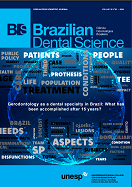CVD and diamond tips: can then influence the bond strength of a total-etch adhesive to dentin?
DOI:
https://doi.org/10.14295/bds.2016.v19i2.1249Abstract
Data (MPa) were analyzed by two-way ANOVA (Surface treatment X Etching time) and Tukey's test (5%). Results and conclusions: Surface treatment with CVD tips (27.70 ± 4.04a) produced significantly higher bond strength values compared to diamond tips (23.96 ± 5.83b), and 5 second etching time on dentin produced similar bond strength values when compared to 10 and 15 second etching times. Objectives: Evaluate the microtensile bond strength of a total-etch adhesive to dentin, using a CVD tip and a diamond tip to use in dentin preparation and varying the etching time. Material and method: The dentin from the buccal face of sixty bovine teeth was exposed and prepared using two different methods (n=30): Group 1 (DT) – a diamond tip on a high-speed handpiece; and Group 2 (CVD) – a CVD tip on an ultrasonic handpiece. Each group used 37% phosphoric acid and was divided into three subgroups, according to the etching time (n=10): Subgroup 5 - 5 seconds; Subgroup 10 - 10 seconds; and Subgroup 15 - 15 seconds. The teeth were restored with Single Bond adhesive and the composite resin Herculite Classic. The specimens were subjected to thermomechanical wear (mechanical cycling/100.000 cycles, thermal cycling/1.000 cycles). Stick-like specimens were obtained and submitted to a microtensile test in a universal testing machine.Downloads
Downloads
Published
How to Cite
Issue
Section
License
Brazilian Dental Science uses the Creative Commons (CC-BY 4.0) license, thus preserving the integrity of articles in an open access environment. The journal allows the author to retain publishing rights without restrictions.
=================




























